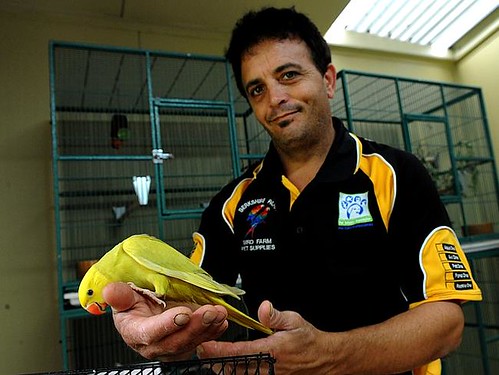Captial's kaka hit by lead poisoning
 Sunday, December 1, 2013 at 23:14
Sunday, December 1, 2013 at 23:14  Nestor meridionalis - Kaka | in
Nestor meridionalis - Kaka | in  Conflict,
Conflict,  Conservation,
Conservation,  Re-introduction,
Re-introduction,  Urban parrots
Urban parrots
 Sunday, December 1, 2013 at 23:14
Sunday, December 1, 2013 at 23:14  Saturday, November 30, 2013 at 7:58
Saturday, November 30, 2013 at 7:58  Chris Hibbard owner of Berkshire Park Bird Farm & Pet Supplies. Chris sold to a group of Indonesians some of his native birds and then reported them to customs.INDONESIAN military officials caught trying to smuggle galahs and parrots on a plane Australia had gifted the island nation were allegedly let off because customs staff deemed it "government-related".
Chris Hibbard owner of Berkshire Park Bird Farm & Pet Supplies. Chris sold to a group of Indonesians some of his native birds and then reported them to customs.INDONESIAN military officials caught trying to smuggle galahs and parrots on a plane Australia had gifted the island nation were allegedly let off because customs staff deemed it "government-related".
 Eolophus roseicapilla - Galah | in
Eolophus roseicapilla - Galah | in  Smuggling
Smuggling  Thursday, November 28, 2013 at 14:54
Thursday, November 28, 2013 at 14:54  Lear's Macaw feeding on its favoured Licuri fruits. Photo: Loro Parque Fundación.Despite a severe drought, the Critically Endangered Lear's Macaw population continues to grow due to careful conservation measures.
Lear's Macaw feeding on its favoured Licuri fruits. Photo: Loro Parque Fundación.Despite a severe drought, the Critically Endangered Lear's Macaw population continues to grow due to careful conservation measures.
 Thursday, November 28, 2013 at 7:20
Thursday, November 28, 2013 at 7:20  Somehow the Orange-bellied Parrot is always getting into trouble. Image by Debbie LustigIf you had to ask an average Australian the name of a threatened bird in this country, many would nominate the Orange-bellied Parrot. Critically endangered, and with fewer than 50 left in the wild, it is justifiably one of Australia’s most well-known endangered species.
Somehow the Orange-bellied Parrot is always getting into trouble. Image by Debbie LustigIf you had to ask an average Australian the name of a threatened bird in this country, many would nominate the Orange-bellied Parrot. Critically endangered, and with fewer than 50 left in the wild, it is justifiably one of Australia’s most well-known endangered species.
 Tuesday, November 26, 2013 at 2:18
Tuesday, November 26, 2013 at 2:18 Birds around the world rely on colourful plumage to identify and assess their kinsmen. Birds see colour using four colour visual pigments in their cone cells in addition to a rod pigment that is used in dim light vision. Each of these visual pigments is made up of one of five opsin proteins (LWS, SW1, SWS2, RH2 and RH1) and a chromophore, where each pigment absorbs a different range of light wavelengths. In some non-avian species the spectral sensitivities of these visual pigments have co-evolved with body colour and differ between individuals of the same species. Curiously, however, to date all studies suggest that the visual pigments vary little within the avian class, and even less within a particular species. To investigate further, Ben Knott, a researcher at Deakin University, and Wayne Davies, from the University of Western Australia, both in Australia, and their colleagues turned to the unusual parrot Platycercus elegans whose plumage can range from red to yellow (p. 4454).